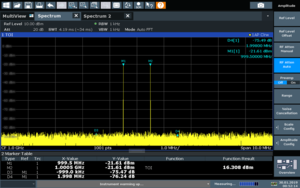互調失真
| 此條目目前正依照其他維基百科上的內容進行翻譯。 (2022年7月5日) |


互調現象或互調失真是兩個或多個不同頻率的信號互相幅度調製後產生額外的頻率分量的現象。互調是由系統中的非線性或時間變化引起的。互調所形成的這些額外分量不僅會出現在原信號的諧波頻率(原信號頻率的整數倍)處,還會出現在原始頻率的和及差處和它們的諧波頻率處。
互調是由信號處理(物理設備以及算法)的非線性行為引起的。如果要對混合信號在一個非線性系統中互調的結果進行理論計算,可以使用非線性系統的特徵的沃爾泰拉級數(也可以使用泰勒級數來進行更近似的計算)。[1]
在現實世界中,幾乎所有的音頻設備都在一定程度上是非線性的。因此,它們都會表現出一定量的互調失真——雖然它們可能低到人類無法察覺的程度。由於人類聽覺系統的特性,互調失真通常比同樣強度的諧波失真更突兀,更容易被人耳察覺。 [2] [3][可疑]
在無線電通訊中,由於互調失真會產生不需要的雜散發射(通常表現為邊帶的形式),互調失真通常是一種有害的現象。在無線電傳輸過程中,雜散發射會增加占用的帶寬,干擾相鄰的信道,從而降低音頻清晰度或增加對頻譜的占用。
雖然互調失真與諧波失真都是由信號處理系統的非線性導致的,但是二者的區別主要在於輸入信號的不同:即使一個簡單的正弦波輸入也會產生諧波失真,而一個更複雜的信號則會因不同頻率之間的互調而產生互調失真。
在音樂中,人們也將互調現象也有意地應用到電吉他上。例如,過載的放大器或效果踏器會在原來的音調的次諧波處產生新的音調,從而產生強力和弦的效果。
互調也不同於「故意的」調製(比如超外差接收機中的混頻器)——混頻器「故意地」使用一個非線性元件(即模擬乘法器)來處理要調製的信號。雖然接收信號與內部振盪器信號的互調產物是有意的,但是接收頻率附近的強信號與內部振盪器信號也會互調,從而產生一個落在接收機通帶內的失真信號。
參見[編輯]
注釋[編輯]
- ^ Rouphael, Tony J. Wireless Receiver Architectures and Design: Antennas, RF, Synthesizers, Mixed Signal, and Digital Signal Processing. Academic Press. 2014: 244 [2022-07-05]. ISBN 9780123786418. (原始內容存檔於2022-07-05).
- ^ Francis Rumsey; Tim Mccormick. Sound and Recording: An Introduction 5th. Focal Press. 2012: 538. ISBN 978-1-136-12509-6.
- ^ Gary Davis; Ralph Jones. The Sound Reinforcement Handbook 2nd. Yamaha / Hal Leonard Corporation. 1989: 85. ISBN 978-0-88188-900-0.
![]() 本條目引用的公有領域材料來自聯邦總務署的文檔《Federal Standard 1037C》 (MIL-STD-188提供支持)。
本條目引用的公有領域材料來自聯邦總務署的文檔《Federal Standard 1037C》 (MIL-STD-188提供支持)。
外部連結[編輯]
- Lloyd Butler. Intermodulation Performance and Measurement of Intermodulation Components. VK5BR. "Amateur Radio," August 1997. 1997 [30 January 2012]. (原始內容存檔於2022-04-07).
